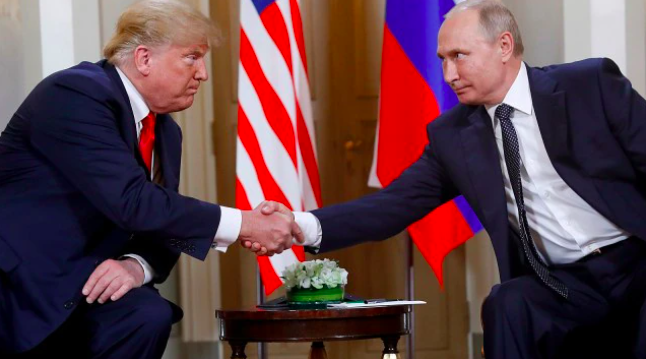After Trump’s Call With Putin, There Are Openings For Peace
Why in the News?
- Biden had not spoken to Putin for nearly three years, considering him a war criminal.
- Almost three years after Russia’s invasion of Ukraine (February 2022), US President Donald Trump and Russian President Vladimir Putin had a phone conversation.
- Trump announced that negotiations to end the war would begin “immediately” following what he described as a “lengthy and highly productive”
- Trump expressed confidence in reaching a peace agreement.
- While advocating negotiations, Trump may have weakened the U.S. position by revealing its stance too early.
Key Developments in Peace Talks
- US Position on Ukraine’s Borders: Before the Trump-Putin call, US Defence Secretary Pete Hegseth, in Brussels, stated that returning to Ukraine’s pre-2014 borders was unrealistic.
- NATO Membership Excluded: Hegseth clarified that the US did not consider Ukraine’s NATO membership as part of the solution.
- No US Troops in Post-War Ukraine: He also assured NATO allies that American troops would not be involved in any post-war security presence in Ukraine.
Challenges to a Peace Agreement
- Territorial Concessions: Russia occupies about 20% of Ukraine and demands Kyiv cede the territory while committing to permanent neutrality.
- Ukraine’s Security Concerns: Ukraine insists on Russian withdrawal from all occupied areas and seeks NATO membership as a security guarantee.
- Zelenskyy’s Negotiation Stance: President Volodymyr Zelenskyy has expressed willingness to negotiate with Putin if Western allies provide credible security guarantees.
Shift in US-Russia Relations
- Change in Tone: The latest developments mark a shift in US-Russia dialogue after nearly three years of no communication between Biden and Putin.
- Stalemate on the Battlefield: The war remains at a standstill, with Russia holding the advantage for over a year despite higher troop losses than Ukraine.
- Foreign Troops in Russia’s Ranks: Moscow’s manpower shortages are evident, with North Korean troops and foreign fighters, including some from India, supporting Russian forces.
NATO’s Role and Challenges
- Limited and Uncoordinated Support: NATO’s assistance to Ukraine has primarily come through bilateral efforts rather than a unified strategy.
- Slow and Inadequate Aid: Military equipment has been supplied in small quantities, with logistical hurdles delaying ammunition and spare parts.
- NATO’s Readiness Issues: The alliance was unprepared for a large-scale European war, leading to depleted military stockpiles.
- Hesitation on Ukraine’s NATO Membership: The US, Germany, Spain, and Belgium have expressed reservations about Kyiv’s accession to NATO, highlighting internal divisions within the alliance.
Concerns and Strategic Considerations
- Ukrainian Fears Over Donbas: Kyiv worries that losing the economically and militarily crucial Donbas region would weaken its future defense capabilities.
- Distrust of Russian Commitments: Ukraine recalls how Russia violated the Budapest Memorandum’s post-Cold War security guarantees by occupying its territory.
- Russia’s Grievance Against NATO: Moscow resents NATO’s eastward expansion, which it sees as a broken oral commitment.
US Strategy and Its Implications
- Potential Leverage in Talks: The US’s “no-NATO” stance for Ukraine may encourage Russia to negotiate.
- Territorial Uncertainty: While the US has not explicitly conceded that all Russian-occupied territory since 2014 belongs to Moscow, negotiations remain open.
- Clearer US Position for Allies: The US has signaled to its allies that it will not be Ukraine’s security guarantor but may continue weapons supplies under a “minerals for weapons” arrangement.
Europe’s Role Moving Forward
- Increased Responsibility for EU: With the US stepping back as a security guarantor, the burden shifts to Europe to lead in military support.
- Need for Military Readiness: The EU must accelerate efforts to strengthen its defense capabilities, having already begun by ramping up munitions production.
Way Forward
- Diplomatic Engagement: Encourage sustained negotiations with a balanced approach to territorial disputes and security concerns.
- Strategic Compromise: Explore a neutral Ukraine framework while ensuring its defense capabilities remain intact.
- Enhanced European Leadership: The EU must strengthen its defense mechanisms and take greater responsibility for regional security.
- Structured NATO Involvement: NATO should streamline aid and coordination rather than relying solely on bilateral support.
- Clear Security Guarantees: Develop a credible security framework for Ukraine without escalating tensions with Russia.
- Economic and Military Stability: Support Ukraine’s reconstruction efforts while preventing over-reliance on external military aid.
- Controlled Military Support: The US and allies should maintain strategic arms supply while preventing direct conflict escalation.
Mains question
Discuss the evolving US-Russia dynamics in the Ukraine conflict, analyzing the role of NATO, territorial concessions, and security guarantees. How should Europe position itself amid shifting geopolitical alignments? (250 words)





